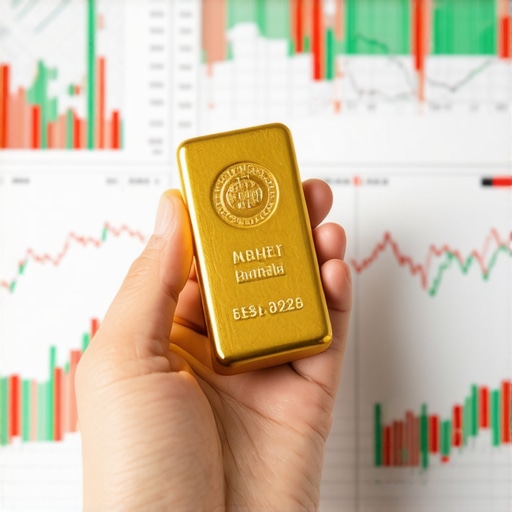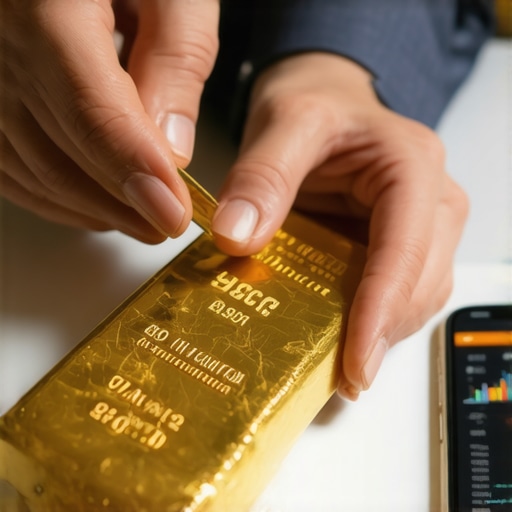What Are Gold ETFs and Why Invest in Them?
Gold Exchange-Traded Funds (ETFs) have emerged as a popular way for investors to gain exposure to the gold market without the need to own physical gold. These funds are designed to track the price of gold, offering a convenient and flexible investment option for both novice and experienced investors alike. But what exactly are Gold ETFs, and how do they work?
Understanding Gold ETFs: The Basics
Gold ETFs are investment funds that trade on stock exchanges, similar to stocks. They hold gold bullion or gold-related assets, allowing investors to buy shares of the ETF that represent a specific amount of gold. This structure provides a way to invest in gold without the challenges associated with physical ownership, such as storage and security.
Investing in Gold ETFs can be particularly appealing for those looking to diversify their portfolios, hedge against inflation, or protect wealth during economic uncertainty. For a deeper understanding of how to trade gold successfully, check out our guide on how to trade gold successfully.
Benefits of Investing in Gold ETFs
1. **Liquidity**: Gold ETFs can be bought and sold throughout the trading day, providing investors with the ability to react quickly to market changes.
2. **Low Costs**: Compared to buying physical gold, investing in ETFs is generally more cost-effective. Management fees are often lower than the costs associated with storing and insuring physical gold.
3. **Diversification**: Gold ETFs allow investors to gain exposure to gold as part of a diversified investment strategy, balancing risk and potential returns.
4. **Accessibility**: For those new to gold investing, ETFs provide a straightforward entry point without the complexities of purchasing and storing physical gold. This accessibility is crucial for beginners looking to explore gold as an investment option.
Key Considerations Before Investing in Gold ETFs
Before diving into the world of Gold ETFs, it’s essential to consider a few factors:
1. **Expense Ratios**: While Gold ETFs generally have lower costs than physical gold, it’s important to compare the expense ratios of different funds to ensure you’re getting the best value.
2. **Tracking Error**: Some ETFs may not perfectly track the price of gold due to management fees and other factors. Understanding these discrepancies can help you make informed decisions.
3. **Market Conditions**: The price of gold can be influenced by various factors, including economic indicators, geopolitical events, and currency fluctuations. Keeping abreast of these trends is vital for successful investing.
For those looking to refine their strategies in the gold market, our post on gold market trends provides valuable insights into current dynamics affecting gold prices.
Conclusion: Is a Gold ETF Right for You?
In conclusion, Gold ETFs present an attractive option for investors seeking to add gold to their portfolios. They offer a blend of liquidity, low costs, and ease of access, making them suitable for both beginners and seasoned investors. However, thorough research and consideration of your investment goals are essential before making any investment decisions. For a more comprehensive understanding of gold demand trends and market forecasts, visit our detailed analysis on gold demand trends.
Understanding the Different Types of Gold ETFs
Gold ETFs come in several varieties, each designed to cater to different investment strategies and risk profiles. Recognizing the differences can help investors choose the right product that aligns with their financial goals.
Physical Gold ETFs
These ETFs invest directly in physical gold bullion, ensuring that each share is backed by a specific amount of physical gold stored in secure vaults. This option appeals to investors seeking tangible assets, reflecting the value of gold directly. For those looking to invest in physical gold, understanding physical gold bars versus coins can provide additional context.
Gold Mining ETFs
Gold mining ETFs focus on companies involved in the extraction and production of gold. These funds offer exposure to the gold sector’s potential appreciation through company stocks, allowing investors to benefit from the rising prices of gold without holding the commodity itself. For insights into the risks and rewards of investing in mining, check out investing in gold mining stocks.
Strategies for Investing in Gold ETFs
Investing in Gold ETFs requires a clear strategy to maximize potential returns. Here are some effective strategies that investors can consider:
1. Dollar-Cost Averaging
This strategy involves consistently investing a fixed amount of money into Gold ETFs at regular intervals, regardless of the price. This approach minimizes the impact of volatility and can lead to a lower average cost per share over time.
2. Hedging Against Inflation
Gold has long been regarded as a hedge against inflation. During periods of rising prices, gold often retains its value, making Gold ETFs a suitable option for protecting purchasing power. For more information on how gold serves as an inflation hedge, visit gold as an inflation hedge.
3. Tactical Asset Allocation
Investors can adjust their exposure to Gold ETFs based on market conditions. For instance, during economic uncertainty, increasing the allocation to gold can provide stability to a portfolio. Conversely, during bullish markets, reducing exposure may enhance overall returns.
Monitoring Performance and Trends
Investors should regularly monitor the performance of their Gold ETFs to ensure alignment with their investment objectives. Key metrics to consider include:
1. Expense Ratios
As mentioned earlier, comparing expense ratios across various ETFs is crucial. Lower expenses can significantly affect long-term returns.
2. Gold Price Trends
Staying informed about gold price movements is vital. Market trends, influenced by factors like geopolitical tensions and economic data, can affect ETF performance. To understand current dynamics, refer to top insights into gold price influences.
3. Market Sentiment
Investor sentiment plays a significant role in gold prices. Monitoring news, reports, and analyses can provide insights into how broader economic conditions may affect gold investments.
Conclusion: Making Informed Decisions with Gold ETFs
Gold ETFs offer a versatile and accessible means of investing in gold for various investor profiles. By understanding the different types of ETFs, employing sound investment strategies, and continuously monitoring performance, investors can navigate the gold market effectively. Always remember to align your investment choices with your overall financial goals and risk tolerance. For a deeper dive into gold market analysis and trends, explore our comprehensive guide on gold market analysis.
Exploring Advanced Strategies for Gold ETF Investment
While understanding the basics of Gold ETFs is essential, employing advanced strategies can significantly enhance your investment outcomes. These strategies cater to different market conditions and allow you to leverage the unique characteristics of gold as a financial asset.
Utilizing Gold ETFs for Diversification
Diversification is a fundamental principle in investing, and Gold ETFs can play a pivotal role in a well-rounded portfolio. By incorporating gold into your investment mix, you can reduce overall risk. Gold often moves inversely to stocks and bonds, making it an excellent hedge against market downturns. To learn more about how to effectively diversify using gold, check out expert tips for investing in gold.
Incorporating Gold ETFs into Retirement Accounts
Another advanced strategy is to include Gold ETFs in your retirement accounts, such as IRAs. This approach allows you to benefit from the potential growth of gold while enjoying tax advantages associated with retirement savings. Understanding the rules and regulations surrounding Gold IRAs is crucial for maximizing this investment method. For a comprehensive guide, visit steps to secure your future with Gold IRAs.
Assessing Market Conditions for Gold Investments
Market conditions significantly influence the performance of Gold ETFs. Investors should remain vigilant and adaptable to changes in the economic landscape. Key factors to consider include:
1. Economic Indicators
Monitoring economic indicators such as inflation rates, interest rates, and employment data can provide valuable insights into gold’s performance. When inflation rises, gold typically retains its value, making it a compelling option for investors seeking stability.
2. Geopolitical Events
Geopolitical tensions can lead to increased demand for gold as a safe-haven asset. Events such as conflicts, trade disputes, and political instability often drive investors towards gold, affecting ETF prices. Staying informed about global events can help you make timely investment decisions.
Long-Term vs. Short-Term Investment Approaches
Deciding between long-term and short-term investment strategies is crucial when dealing with Gold ETFs. Both approaches have distinct advantages, and your choice should align with your financial goals.
Long-Term Investment: Buy and Hold
The buy-and-hold strategy involves purchasing Gold ETFs with the intention of holding them for an extended period. This approach allows investors to ride out short-term market fluctuations and benefit from the long-term appreciation of gold. Historically, gold has proven to be a robust long-term investment, especially during economic uncertainty.
Short-Term Trading: Capitalizing on Volatility
For those interested in short-term gains, trading Gold ETFs based on market volatility can be a lucrative strategy. This approach requires careful market analysis and timing, capitalizing on price fluctuations to generate quick profits. However, it also involves higher risks and demands a more hands-on approach.
Conclusion: Maximizing Your Gold ETF Investments
In conclusion, successfully investing in Gold ETFs involves a combination of understanding the market, employing advanced strategies, and aligning your investments with your overall financial goals. By continuously educating yourself on market dynamics and adjusting your strategies accordingly, you can maximize your returns in the gold investment landscape. For further insights into market trends, explore gold market analysis to stay informed and enhance your investment strategy.
Understanding the Risks in Gold ETF Investments
While Gold ETFs offer numerous advantages, it’s crucial to acknowledge the potential risks associated with these investments. Understanding these risks can help you make informed decisions and safeguard your portfolio. Key risks include market volatility, management fees, and the impact of geopolitical uncertainties.
Market Volatility and Its Effects
Gold prices can fluctuate significantly due to various factors, including economic conditions and investor sentiment. During times of high volatility, the price of Gold ETFs may experience rapid changes, impacting your investment’s value. To mitigate this risk, consider diversifying your portfolio across different assets, as discussed in our best practices for evaluating gold price trends.
Management Fees and Costs
Another aspect to consider is the management fees associated with Gold ETFs. These fees can eat into your profits over time, making it essential to compare different ETFs and choose those with lower expense ratios. This evaluation process is vital for maximizing your investment returns.
Evaluating Gold ETF Performance: Key Metrics
To effectively evaluate the performance of your Gold ETFs, consider key metrics that can provide insights into their success. These metrics include total return, tracking error, and liquidity.
Total Return: What to Look For
Total return encompasses both price appreciation and dividends, giving you a comprehensive view of your investment’s performance. When assessing Gold ETFs, look for those that have consistently delivered strong total returns, especially during periods of economic uncertainty.
Understanding Tracking Error
Tracking error measures how closely an ETF’s performance aligns with its benchmark, which is usually the price of gold itself. A low tracking error indicates that the ETF effectively mirrors gold’s price movements, making it a reliable investment option. Understanding this metric is crucial for selecting the right Gold ETF to fit your investment strategy.
Advanced Trading Strategies for Gold ETFs
Incorporating advanced trading strategies can help optimize your Gold ETF investments. Techniques such as dollar-cost averaging, options trading, and leveraging can enhance your investment returns.
Dollar-Cost Averaging: A Smart Approach
Dollar-cost averaging involves investing a fixed amount in Gold ETFs at regular intervals, regardless of market conditions. This strategy helps mitigate the effects of volatility, as it allows you to buy more shares when prices are low and fewer shares when prices are high. To learn more about effective investment strategies, refer to our top 10 gold investment strategies.
Options Trading: Adding Flexibility
For investors looking to enhance their Gold ETF strategies, options trading offers a level of flexibility. By buying call or put options, you can hedge against price fluctuations or leverage your position for greater returns. However, options trading carries inherent risks and should be approached with caution.
Conclusion: Navigating the Future of Gold ETF Investments
In summary, investing in Gold ETFs requires a comprehensive understanding of market dynamics, risk assessment, and advanced trading strategies. By continually educating yourself and adapting your approach, you can navigate the complexities of gold investments effectively. For additional insights, explore gold market analysis to stay updated on trends that may affect your investment decisions.
Frequently Asked Questions About Gold ETFs
1. What are Gold ETFs?
Gold ETFs (Exchange-Traded Funds) are investment funds that trade on stock exchanges and invest primarily in gold. They aim to track the price of gold and offer investors exposure to gold without the need to physically own it.
2. How do Gold ETFs work?
Gold ETFs work by pooling money from investors to purchase physical gold or gold-related assets. The value of the ETF shares reflects the price of gold, allowing investors to buy and sell shares just like stocks.
3. What are the benefits of investing in Gold ETFs?
Investing in Gold ETFs provides several advantages, including liquidity, diversification, and low management fees compared to traditional gold investments. They offer an easy way to gain exposure to gold prices.
4. Are there risks associated with Gold ETFs?
Yes, risks include market volatility, management fees, tracking error, and the impact of geopolitical events on gold prices. It’s essential to assess these risks and diversify your investment portfolio.
5. How can I choose the right Gold ETF?
To choose the right Gold ETF, consider factors like total returns, expense ratios, liquidity, and tracking error. Research different ETFs and compare their performance against the gold price benchmark.
6. Can I invest in Gold ETFs through a retirement account?
Yes, you can invest in Gold ETFs through tax-advantaged retirement accounts like IRAs or 401(k)s, allowing for potential tax benefits while investing in gold.
7. What is the difference between Gold ETFs and physical gold?
Gold ETFs provide exposure to gold prices without the need for storage and insurance, while physical gold requires safekeeping. ETFs are more liquid and can be easily traded on stock exchanges.
8. How does gold price affect Gold ETFs?
The price of gold directly impacts the value of Gold ETFs. When gold prices rise, the value of Gold ETFs typically increases, and vice versa. Understanding gold market trends is crucial for investing in these ETFs.
9. Are Gold ETFs suitable for all investors?
Gold ETFs can be suitable for a variety of investors, especially those looking for diversification and a hedge against inflation. However, individual investment goals and risk tolerance should be considered.
10. How often should I review my Gold ETF investments?
Regularly reviewing your Gold ETF investments is essential to ensure they align with your overall investment strategy and market conditions. Consider evaluating them at least annually or during significant market changes.
Authority Resources on Gold ETF Investment
For those looking to deepen their understanding of Gold ETFs and investment strategies, the following resources are highly recommended:
- SPDR Gold Shares – One of the largest Gold ETFs, providing insights into gold investment strategies.
- Investopedia: Gold ETF – A comprehensive guide that covers the basics and intricacies of Gold ETFs.
- World Gold Council – An authoritative source for gold market trends and investment insights.
- Kitco News – A trusted platform for gold market news, analysis, and price updates.
- Morningstar – Offers research and ratings on Gold ETFs and other investment options.
Conclusion: Mastering Gold ETF Investments
In conclusion, navigating the world of Gold ETF investments requires a solid understanding of market dynamics, risk management, and strategic trading techniques. With the right knowledge and resources, you can effectively harness the benefits of Gold ETFs to enhance your investment portfolio. By leveraging the insights provided in this comprehensive guide, you are well-equipped to make informed decisions and maximize your returns in the gold market.










